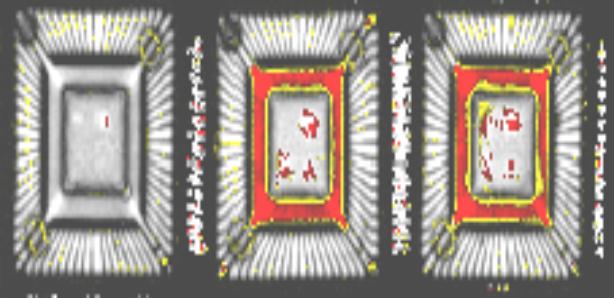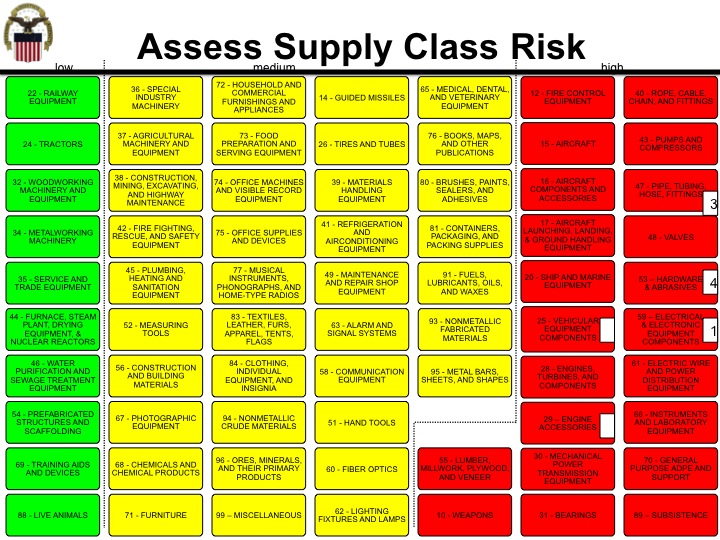Plant DNA & Micron Patterns: DLA Gets High-Tech Vs. Counterfeiters
Posted on

A failed microcircuit. (Naval Sea Systems Command)
“There’re a lot of chiselers out there,” Vice Adm. Mark Harnitchek sighed. Congressional angst over counterfeit parts has understandably focused on ersatz electronics, many of them from much-mistrusted China, but as head of the Defense Logistics Agency, Harnitchek has found fakes in everything from air filters to rubber tubing. “There’re folks that counterfeit those, believe it or not,” Harnitchek told me.
That’s why DLA is expanding its war against fakery to new fronts by funding research into two very different types of authentication technology from two very different companies. Applied DNA Science repurposes plant DNA as an invisible, indelible seal of authenticity. ChromoLogic LLC‘s promising but less-proven technique uses digital cameras to scan microscopic patterns on the surface of materials, patterns which give each manufacturer a unique fingerprint.

Vice Adm. Mark Harnitchek
DLA’s techniques have to get more sophisticated. “You wouldn’t believe the difference in the counterfeit microcircuits [now compared to] five or six years ago,” DLA expert Christine Metz told me. “You used to see where they were would misspell the company’s name [in the label]. You used to be able to rub them with acetone, which is basically nail polish remover, and the marking would come off. They’re much better than that now.”
DLA jumpstarted its authentication effort by funding an 18-month, $1.85 million pilot project by Applied DNA, whose tags it now requires on every microcircuit that it buys. At first, “there was huge pushback — and some of it wasn’t totally logical,” Metz told me. “[Even when] we tried to pay for it, there was always another reason why they didn’t want to do it, which was disappointing.”
“A lot of companies stopped supplying for a while, then some of the major ones finally came back,” Metz said. “We were really scrambling for a while. It is running very smoothly right now.”
Today, 34 suppliers provide DNA-tagged microcircuits to DLA. Currently, some apply the tags themselves while others outsource the tagging, in both cases using Applied DNA’s equipment. To save money and to simplify the process, however, DLA plans to move the work in-house and have government employees do all the tagging by the end of the year. Overall, Metz said, DNA tagging of microcircuits is “a mature program for us.”
But because counterfeiting extends well beyond microcircuits, in August DLA awarded $2.97 million in Rapid Innovation Fund (RIF) contracts to develop authentication techniques for six broad Federal Supply Groups from abrasives to tubing. (By contrast, microcircuits are just a single Federal Supply Class, FSC 5962, within the Electrical and Electronic Equipment group). The six categories, in order of risk, are Electrical and Electronic Equipment Components (FSG 59); Bearings (FSG 31); Vehicular Equipment Components (FSG 25); Engine Accessories (FSG 29); Pipe, Tubing, Hose, and Fittings (FSG 47); and Hardware and Abrasives (FSG 53).

“We did a risk assessment of all of our Federal Supply Classes,” DLA’s Metz told me. “We looked at where we had identified suspect counterfeits [in the past:] They may not have gone through litigation yet but our tech lab is fairly confident somebody was trying to fool us. ”
Unlike microcircuitry, which can be vital to the functioning of high-performance weapons systems, Harnitchek told me, “it’s not a question for these other supply classes of catastrophic failure; it can be just degraded performance.” It’s a lot like aftermarket car parts, the admiral explained. “There are some times when I’ll buy a part for my old foreign car here which just doesn’t perform correctly, Fit is fine and it appears to function okay, but it doesn’t last as long or it doesn’t work as well.”
That’s annoying enough when the part goes in your family car. It’s a lot worse when it leaves some military mechanic tearing his hair out in a war zone, wondering why he’s working himself ragged while the supply officer yells at him for using up spare parts faster than he can replace them, and the commander wants to know why his equipment isn’t battle-ready.
The problem with protecting a wide range of different kinds of parts, however, is that they are made of different materials undergoing different stresses. Painting on a DNA tag works well for microcircuits, but not necessarily for, say, ball bearings. “Bearings have to have a very smooth surface,” Metz noted. “The whole point is things don’t stick to it.”
So the big attraction of ChromoLogic’s technique is that it doesn’t require applying any kind of marker to the part. Instead, it relies on close examination of physical properties inherent to any material. It turns out that even a bearing isn’t perfectly smooth, after all.

Naresh Menon
“There is no such thing as a perfectly flat surface, period. There’s always roughness,” said ChromoLogic founder Naresh Menon, a particle physicist by training. “When you manufacture anything there’s always a surface texture… Even a sheet of paper will have some surface roughness.”
ChromoLogic uses ordinary digital cameras — albeit with “very specialized, optimized settings,” Menon told me — to take a picture of the part in question. Even features individually as small as a micron across — one millionth of a meter — create identifiable patterns when they repeat regularly across the surface of an object. Then their algorithms reduce the distinctive texture to a single kilobyte of data, a compact digital fingerprint that can be quickly checked against a library of authentic patterns stored in a data “cloud.”
“The fundamental advantage that we have is we don’t have to put any tag on the material,” Menon said: They’re measuring the qualities any material inherently has already. So while ChromoLogic started out fighting counterfeit microcircuits, just like Applied DNA, it sees its technology as having far wider application.
Applied DNA, however, is pretty confident they can get their DNA tags to stick on all sorts of components, not just microcircuits. “DNA is a pretty robust molecule all on its own,” said the company’s vice-president for military and government affairs, Janice Meraglia. That’s why it’s the basis of all life on Earth, after all.

Janice Meraglia
Applied DNA further stabilizes the natural deoxyribonucleic acid “so it can withstand exposure or stresses in different environments,” Meraglia told me. Even on electronics, “we have to stabilize our mark [against] thermal pressure and maybe nuclear exposure or radiation,” she said. “In another application, we may have to have the DNA withstand an extrusion process,” for example so the DNA tag can be molded into a plastic at the point of manufacture.
“We have to apply the mark in different ways, [too]: maybe with an inkjet here, maybe with an epoxy ink there, maybe with a textile binding approach,” she went on. “It’s not only getting DNA into or onto [the product], it’s getting it back out [for testing]: We developed extraction protocols that are appropriate for different industries.” Applied DNA allows both a quick CSI-like check by shining a special light on the mark, which can be made to glow, and a more thorough lab test that typically involves swabbing the mark to get a sample.
The two companies both have two years to prove they can combat counterfeiting across all six Federal Supply Groups. Applied DNA estimates that DLA buys 140 million parts in these six categories every year, compared to roughly 100,00 microcircuits now being marked. It’s a staggering increase in scale, even if DLA ends up splitting the market, as is likely, by using both companies’ techniques depending on which is best suited for what material.
But the big money is beyond the military. If commercial industry gets really worried about counterfeit parts, “then scale goes to a whole different level,” Meraglia told me. “Right now, cars are literally driving themselves,” she said, citing Google’s recent experiments. “The same parts that are guiding missiles are parking cars. It becomes much more personal.”
Subscribe to our newsletter
Promotions, new products and sales. Directly to your inbox.
